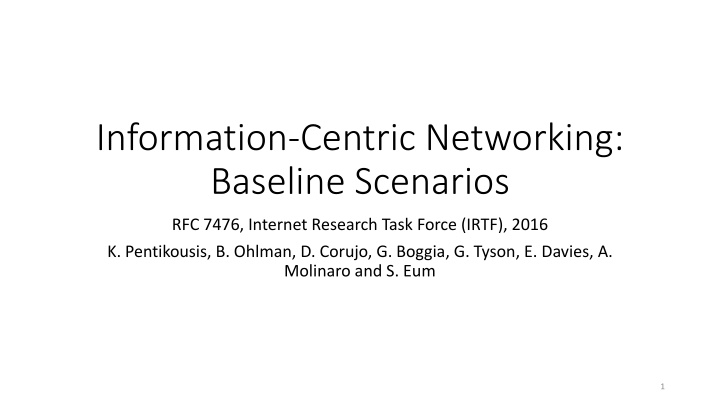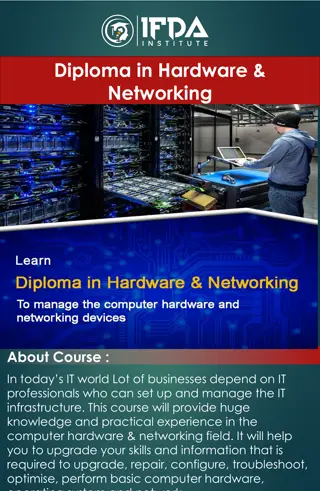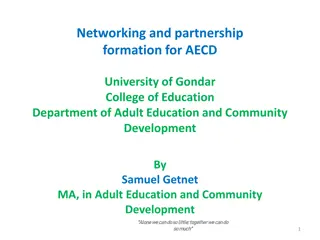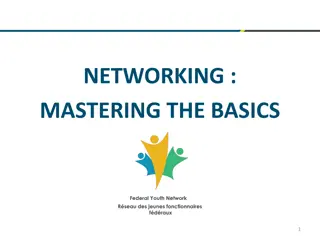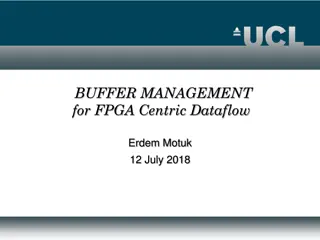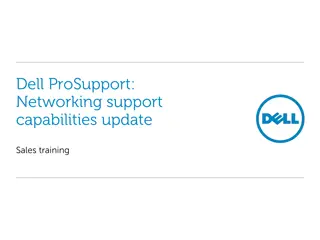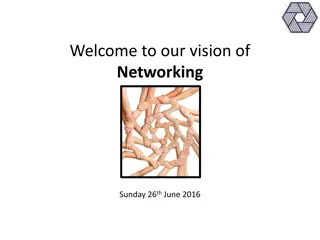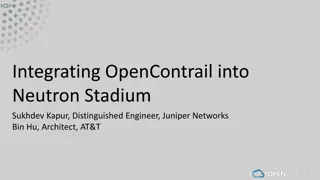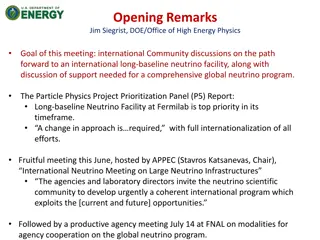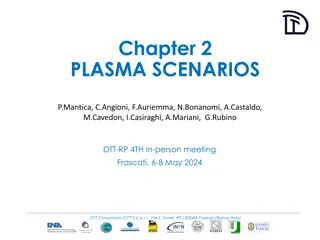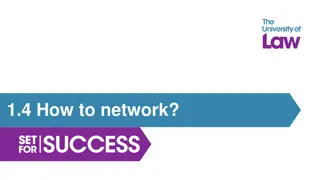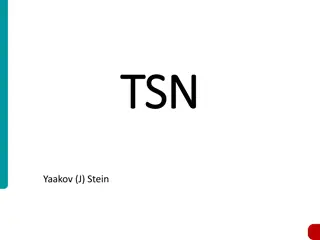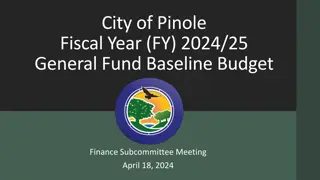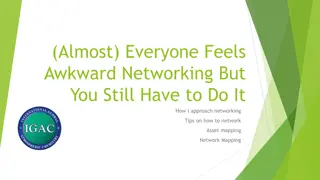Information-Centric Networking Baseline Scenarios
ICN is an approach to evolve Internet infrastructure to support accessing Named Data Objects as a first-order network service. Features include naming, caching, multicast delivery, and content dissemination in scenarios like social networking, real-time communication, mobile networking, and more. Evaluations involve proof-of-concept assessments, performance studies on VoIP calls, and multimedia conferencing system evaluations highlighting gains in scalability and security.
Download Presentation

Please find below an Image/Link to download the presentation.
The content on the website is provided AS IS for your information and personal use only. It may not be sold, licensed, or shared on other websites without obtaining consent from the author.If you encounter any issues during the download, it is possible that the publisher has removed the file from their server.
You are allowed to download the files provided on this website for personal or commercial use, subject to the condition that they are used lawfully. All files are the property of their respective owners.
The content on the website is provided AS IS for your information and personal use only. It may not be sold, licensed, or shared on other websites without obtaining consent from the author.
E N D
Presentation Transcript
Information-Centric Networking: Baseline Scenarios RFC 7476, Internet Research Task Force (IRTF), 2016 K. Pentikousis, B. Ohlman, D. Corujo, G. Boggia, G. Tyson, E. Davies, A. Molinaro and S. Eum 1
Information-Centric Networking (ICN) ICN is an approach to evolve the Internet infrastructure to directly support accessing Named Data Objects (NDOs) as a first-order network service. FEATURES: 1. Naming 2. Caching 3. Multicast delivery 4. Content dissemination (Requestor and Publisher) 2
Scenarios 1. Social Networking 2. Real-Time Communication 3. Mobile Networking 4. Infrastructure Sharing 5. Content Dissemination 6. Vehicular Networking 7. Delay- and Disruption-Tolerance 8. Internet of Things 9. Smart City 3
Scenario 1: Social Networking A single user addresses a large number of recipients, some of which receive the new message immediately as they are online at that instant, while others receive the message whenever they connect to the network. Online Offline User Recipient 4
Scenario 1: Social Networking (cont.) BENEFITS: content dissemination 1. Multicast delivery 2. Caching EVALUATION: a proof-of-concept evaluation Users with ordinary smartphones can browse a list of members or content using a name, and download the content selected from the list. 5
Scenario 2: Real-Time Communication Quality telephony services are feasible with at least one ICN approach. STUDY 1: Description: The performance of a Voice over IP (VoIP) call using an information-centric approach was compared with that of an off-the-shelf VoIP implementation using Real-time Transport Protocol/User Datagram Protocol (RTP/UDP). STUDY 2: Description: The study reduces the overhead that may arise in one-to-one communication employing an ICN architecture. 6
Scenario 2: Real-Time Communication (cont.) An evaluation of an ICN system should demonstrate capabilities beyond feasibility. STUDY 3: Description: The multimedia conferencing system includes ICN-based conference discovery, speaker discovery, and voice data distribution. Evaluation: The reported evaluation results point to gains in scalability and security. STUDY 4: Description: The study explores the feasibility of implementing a Massively Multiplayer Online Role-Playing Game (MMORPG) and show that stringent temporal requirements can be met. Evaluation: The scalability is significantly improved when compared to a host-centric (IP-based) client-server system. 7
Scenario 2: Real-Time Communication (cont.) ISSUE: data naming 1. A single name for the entire content -> Significant distribution delays 2. Individual name for every small chunks -> Naming scalability concerns /name/of/the/content /name/of/the/chunk1 Chunk 1 Chunk 2 Content /name/of/the/chunk2 EXERCISES of ICN: 1. Satisfy real-time Quality of Service (QoS) requirements 2. Provide improved user experience 8
Scenario 3: Mobile Networking REQUIREMENTS: 1. Service continuity METRICS of EVALUATION: 1. Handover latency 2. Network overhead (due to the signaling) POTENTIALS: 1. Broadcast nature of wireless access technologies CONSIDERATIONS: 1. Broadcast Storms 2. Cross-scenarios: social networking and real-time communication 9
Scenario 4: Infrastructure Sharing Since the network of ICN secures the information objects, all devices with network access and storage capacity can contribute their resources. CONSIDERATIONS: 1. User content consistency 2. Resources availability 3. Policy and commercial considerations 4. Communication-computation-storage tradeoffs 10
Scenario 5: Content Dissemination Information consumer issues independent requests for content based on information identifiers, and stitches the pieces together irrespective of "where" or "how" they were obtained. The information dissemination in a VANET scenario revolves around "where" and "when . CONSIDERATIONS: 1. Information integrity 2. Filtering 3. Access authorization 4. Cross-scenarios 11
Scenario 6: Vehicular Networking BENEFITS: 1. Content caching: It speeds up data retrieval with intermittent on-the-road connectivity 2. Asynchronous data exchange: A mobile node can serve as a link between disconnected areas. EXERCISES of ICN: 1. Scalability 2. Caching 3. Content dissemination 4. Mobility of consumer and producer 12
Scenario 7: Delay- and Disruption-Tolerance Delay- and Disruption-Tolerance Networking (DTN) is a set of protocols that act together to enable a standardized method of performing store-carry-and-forward communications. Store Carry C C A Forward Source Store Forward B B D Carry 13
Scenario 7: Delay- and Disruption-Tolerance (cont.) BENEFITS: 1. Caching(store) 2. Late binding of names to locations 3. Long-lived data EVALUATION: Two scenarios: (1) Opportunistic Content Sharing (2) Emergency Support and Disaster Recovery Input: (1) Environment (2) Workload 14
Scenario 7: Delay- and Disruption-Tolerance (cont.) ENVIRONMENT: The environment can be abstractly modeled by a time series of active connections between device pairs. 1. Synthetic: a (mathematical) model of user behavior 2. Trace-driven: the mobility of real users WORKLOAD: It is modeled much like the workload within the other scenarios. 1. statically at the beginning of the simulations 2. dynamically based on a model of user behavior 15
Scenario 7: Delay- and Disruption-Tolerance (cont.) Opportunistic Content Sharing: This occurs when mobile nodes create opportunistic links between each other to share content of interest. Interaction: altruistic or incentivized Environment: trace-driven Emergency Support and Disaster Recovery: It is typical for infrastructure to be damaged or destroyed, leading to the collapse of traditional forms of communications. Interaction: altruistic Environment: synthetic 16
Scenario 8: Internet of Things (IoT) The IoT is a network of physical objects, such as vehicles, machines, home appliances, that use sensors and APIs to connect and exchange data over the Internet. ISSUE: 1. Hierarchical and self-certifying naming schemes 2. Low power consumption 3. Heterogeneous type of data, technologies and environment 4. Information as real-time traffic 17
Scenario 9: Smart City Smart cities will be based on the following innovation axes: smart mobility, smart environment, smart people, smart living, and smart governance. EXERCISES of ICN: 1. Capacity of using ICN for managing extremely large data sets 2. Scalability in distributed services 3. Feasibility of ICN in a complex application 4. The possible drawbacks related to privacy and security issues in complex networked environments 18
